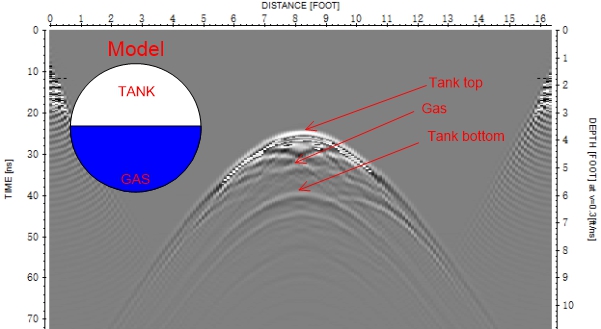Ground penetrating radar (GPR) data can be complicated and difficult to interpret. GPR data simulation is a great way to help interpretation. Fiberglass underground storage tanks (USTs) have been more and more popular. Unlike a traditional steel UST, the top of a fiberglass UST is "transparent", making it possible to see liquid level and the tank bottom in GPR data, providing more underground information. But at the same time, the GPR data is more complicated and can be easily misinterpreted. So a GPR data simulation is done here to minimize the chance of misinterpretation
There are 3 simulated situations: an empty tank, a tank with some gasoline, and a half full tank. We can see from the simulation that both top and bottom of the tank show up very nicely in the GPR data. In comparison, the top of gasoline levels are less obvious but still visible. It's interesting to see product levels show up as hyperbolas instead of horizontal layers, due to the round shape of tank and the velocity difference between soils and air. It's counter-intuitive to GPR operators who are used to do underground utility locating or underground storage tank locating, and the signals can be easily ignored or misinterpreted.
GPR simulation usually can not provide data perfectly matching field data, but could provide great insights for field data interpretation. Data simulation is a great way to enhance the GPR operator's ability to understand data and consequently make real-time field scanning more productive. This is one of our unique ways to train our field crew for GPR scanning.




